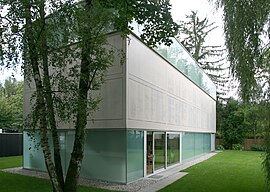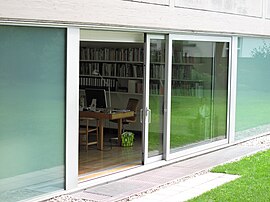Goetz Collection
The Goetz Collection is a collection of contemporary art in Munich , which is shown in temporary exhibitions in its own museum building. A visit is only possible after prior registration via the Internet.
location
The museum building of the Goetz Collection is located at Oberföhringer Straße 103 in Munich's Oberföhring district .
Concept and claim
The Goetz Collection would like to show the independence of art in its temporary exhibitions. The exhibitions should be designed and presented in such a way that the works of art show the visitor the world in a way previously unknown. In this way, the Goetz Collection wants to promote an openness of perception and a constant correction of their own thinking and views among all visitors .
collection
The Goetz Collection was created as a private art collection compiled by Ingvild Goetz from Munich, with works of contemporary art from the 1960s to the present day . An early focus was the Arte Povera of the 1960s. It was later expanded to include works by young American and British artists.
Today the collection consists of the entire spectrum of contemporary artistic forms of expression: paintings , graphics , drawings , photographs , video and film works as well as multiple projections and spatial installations . A separate area was subsequently created for media art in the basement, which meets all the technical and spatial requirements for this.
In September 2013 Ingvild Goetz donated the museum and the part of the collection that she owned to the Free State of Bavaria . The works in which family members have co-ownership will remain in the museum on permanent loan when it is transferred to the Free State.
Museum building
The Goetz Collection has its own museum building, designed by the Swiss architects Herzog & de Meuron and executed by Josef Peter Meier-Scupin . The sale of Cy Twombly's works helped finance the building. Temporary exhibitions have been held here since 1993 in order to present the holdings of the Goetz Collection. In 2004, the museum building in the basement was expanded to include the media area “BASE103” so that the media work of the Goetz Collection can be shown appropriately.
Conception of the museum building
The museum building stands as a solitaire on a fenced, park-like area. Since the building regulations for the residential area imposed limits on the building in terms of floor space and height, the exhibition space had to be supplemented by a basement in order to achieve the desired exhibition space. The two floors have a ceiling height of 5.5 and 4 meters respectively and are provided with unpainted plaster.
At the same time, the usual hierarchy of rooms was reversed in the building design: the large exhibition hall is in the basement, three smaller exhibition rooms on the upper floor. Instead of a classic skylight, the decision was made to use strips of frosted glass below the ceiling so that daylight can enter the upper storey as well as the basement without glare and evenly. The lighting situation is the same in all exhibition rooms - regardless of whether you are in the basement or on the upper floor. This made it possible to create an equivalent spatial quality on both exhibition levels.
Conception of the media area BASE103
When the museum building was expanded for the presentation of the media works - with the media area "BASE103" - the existing storage rooms of the Goetz Collection were extended and converted by the Munich architect Wolfgang Brune in consultation with Herzog and de Meuron.
The aim was to create a media space here that takes into account the special way of seeing when perceiving media art. At the same time, this room should make it possible for visitors to concentrate exclusively on the presentations presented and not be distracted by anything. For this purpose, the media area was lined with dark felt, which creates a perfect acoustic and optical contrast to the other exhibition rooms.
The entrance to this exhibition area was designed in the form of a dark lock: A few steps lead to the first small film room. Here the lighting slowly decreases. The film room itself is separated by a curtain and can thus be completely darkened. Connected to the film room is the large, divisible media room, which is technically designed for every type of projection. The media area is again closed by a small room, which is lighter and thus forms a bridge to the light exhibition rooms in the rest of the museum building. This sequence of rooms with a small dark room, a large dark room and a small lighter room should also meet the various requirements for the presentation of filmic and media works.
The experience gained with the exhibition >> fast forward (2003/2004) at the ZKM in Karlsruhe was incorporated into the technical equipment of the three media rooms : All wall shells were pre-installed in the rooms. In addition, the large media room has an accessible installation shaft. The ventilation was implemented - as in the entire museum building - with a circulating air system. All rooms are ventilated with mechanical assistance, with the incoming outside air only being slightly conditioned.
It was important that by expanding the museum building to include the media area, the principle of simplicity of means and the compact format were retained.
Library
The curatorial and scientific work of the collection is based on a reference library with around 7,000 volumes, the focus of which is on the art of the second half of the 20th and the upcoming 21st century. Here you can find artist monographs on all artists represented in the collection as well as a selection of international group and exhibition catalogs since the late 1970s. There are also inventory catalogs of important museums, collections and galleries as well as a selection of important art magazines and journals.
Collection archive
The collection archive documents the work and development of the Goetz Collection artists as well as the history of the collection. The use for scientific purposes is possible after registration.
staff
The employees of the Goetz Collection take care of the diverse collection in terms of art history , conservation , restoration and curation .
Cooperations
- House of Art (Munich)
- Munich Film Museum
- ZKM - Center for Art and Media Technology Karlsruhe
- Weimar New Museum
- State capital Munich
- New Museum Weserburg Bremen
- Bergen Art Museum
- Fries Museum Leeuwarden
- State art gallery Baden-Baden
- Museum Villa Stuck , Munich
- Deichtorhallen , Hamburg
- State Gallery Rudolfinum Prague
- Brandts Art Gallery , Odense
- Seedamm cultural center , Pfäffikon
- The Center for Contemporary Art - Ujazdowski Castle in Warsaw
- ZKMax , Munich
- Edith Russ House for Media Art, Oldenburg
- Munich Adult Education Center
literature
- Gerhard Mack: Herzog & de Meuron 1989-1991. The complete work Volume 2 , Birkhäuser, Basel 1996, p. 73
Web links
- Goetz Collection
- Goetz Collection at www.muenchen.de
- ( Page no longer available , search in web archives: Goetz Collection on the homepage of the Department of Art Studies at LMU )
- fast forward - media art (presentation of media art from the Goetz Collection at the ZKM)
Individual evidence
- ↑ City bus 188, stop: Bürgerpark Oberföhring
- ^ Süddeutsche Zeitung: Collector Goetz donates private collection , September 5, 2013
- ^ Architecture - Goetz Collection. Retrieved September 4, 2019 .
- ↑ a b Lars Reichardt, Nan Goldin (photo): Do I really need that? In: Süddeutsche Zeitung Magazin. 2012, accessed on May 8, 2012 (issue 18/2012).
Coordinates: 48 ° 9 ′ 58 ″ N , 11 ° 37 ′ 23 ″ E

